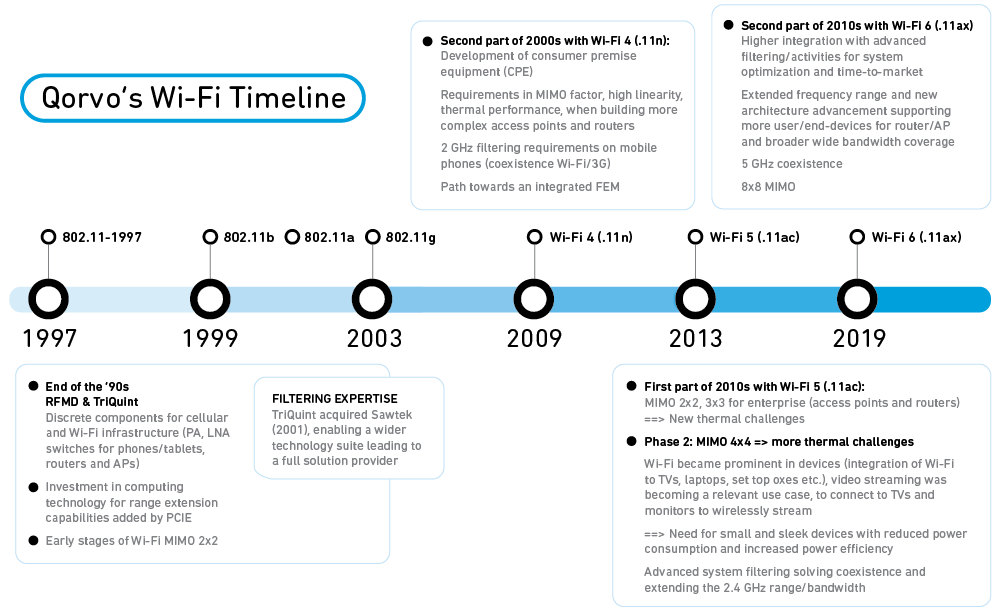Qorvo's Cees Links, now considered a Wi-Fi pioneer, wrote a 160-page book in 2002-2003 titled The Spirit of Wi-Fi. In his book Cees explains how the first wireless LANs were created, and how a fortuitous meeting with Steve Jobs changed the face of wireless communications in the late 1990s – a time when everything was wired.
Qorvo subsequently began it's evolution as Wi-Fi was launched at the end of the 90's becoming the industry leader it is today. Each new step of Qorvo's development was driven by a deep look into market and consumer trends in order to better understand its customers' needs and provide the adequate solution for the time. Qorvo has always been involved in Wi-Fi progression, working on the latest generation standards and following the Wi-Fi regulatory roadmap all the while differentiating itself thanks to improvements in efficiency and advanced filtering technology.
Below is a brief overview of how Qorvo accompanied Wi-Fi developments over the years:

Let's take a step back in time to explore the roots of the Wi-Fi movement and how industry predictions from leaders like Cees have played a role in shaping the wireless landscape that exists today.
Transport yourself all the way to 2002-2003. Remember the gadgets you had around you? You probably were still holding on to your wired home phone's land line and might have been lucky to have the top-selling cell phone at the time — the Nokia 6610. You probably had a desktop computer, not a laptop, and Wi-Fi was just starting to become more commonplace. Netflix only had mail-service DVDs, and Facebook hadn’t yet supplanted Myspace as a top social media platform.
This was the environment in which Cees made some bold predictions about the future of wireless technology yet to come. Predicting the future can be fun – but tricky. In an interview with Cees, you can see how his predictions matched up with reality and where he thinks wireless technology might go from here.
Discussing the Future of Wi-Fi
Question: Wi-Fi was in the early stages of adoption when you wrote your book. At the time, you described it as a rich standard that would be with us for the coming decades and provide a solid basis for newer capabilities. Wi-Fi 6(802.11ax), is expected in 2019. What do you think will come next, or what challenges will have to be solved in the future?
Cees: Wi-Fi (IEEE 802.11) is indeed still with us and going strong — no end-of-life in sight! From 802.11b to a, g, n, ac, ad and now .11ax (Wi-Fi 6), high-performance wireless technologies have been evolving from the beginning of this century. Essentially, there have always been two major drivers: good coverage in your whole house (or office, etc.) and faster speed. There have been other underlying drivers, like reducing heat consumption (to avoid your smartphone from melting) and integrating functions while reducing the price. At this moment, the need for higher data rates, bandwidth and capacity will continue, without compromising the coverage. This is in line with the fact that video continues to be more and more important. Why should it take hours to download the latest series before going on a trip?
Recently, I wrote a white paper, Wi-Fi 6 (802.11ax): What's It All About?, and indeed, higher speed, capacity and bandwidth are the key ingredients to success today. Everybody is connected on the same channel at the same time, and we always want more speed. There will be no rest for service providers to provide us with more bandwidth to our homes!
New smart home use cases?
Question: Let's talk about the smart home. There are multiple use cases that could be created to make the home smarter, like smart lighting, home security or lifestyle monitoring. You mention in your book that household applications will grow quickly, once the infrastructure is in place. Is this the case today?
Cees: Interestingly, the idea of low-power Wi-Fi was floating around a lot, and what we see today is that both Zigbee (which is essentially low-power Wi‑Fi) and Bluetooth Low Energy (BLE) have established themselves — although frankly, it took longer than I expected. I think it took longer because the value proposition of Zigbee and BLE isn’t so much higher data rate, but longer battery life — which doesn’t tie into a strong application like video.
Normally, a company begins with the business case for a product, which drives the application space. But with the smart home, it's the other way around — the application is driving the business case. This means it's taken longer to establish the value of the smart home — but it's getting there, slowly but surely.
 With the Internet of Things – the "connected" house – the challenge is still the infrastructure. Each application almost needs its own gateway connected to the router to have lights, sensors or smart meters connected to the internet, making implementation unnecessarily expensive. One of the larger steps forward are routers and set-top boxes with Zigbee and BLE integrated, and that’s what the industry is working on now.
With the Internet of Things – the "connected" house – the challenge is still the infrastructure. Each application almost needs its own gateway connected to the router to have lights, sensors or smart meters connected to the internet, making implementation unnecessarily expensive. One of the larger steps forward are routers and set-top boxes with Zigbee and BLE integrated, and that’s what the industry is working on now.
I think the future of the smart home is distributed Wi-Fi, with a pod in every room serving as an access point. With Wi-Fi 6 (802.11ax) and distributed Wi-Fi, consumers will have Wi-Fi everywhere in their home or office. Each pod can also carry wireless communication technologies like Zigbee or Bluetooth. It will also allow command through voice activation and enable talking to the internet as a common feature in every room. This new infrastructure will help develop multiple use cases in the smart home — all using the same infrastructure.
Where will Wi-Fi go from here?
Question: One thing is for sure — we're excited to be a part of this technology evolution and help shape the future of Wi-Fi. Where do you think we'll stand in another 15 years?
Cees: There's no shortage of demand for higher data rates and longer battery life, so developments in this area will continue. Nowadays, I have to charge my laptop and my phone every day, which is a nuisance that I grudgingly accept. Data rates continue to be a bottleneck, but that probably needs to be extended toward system-level performance. My Wi-Fi is way faster than the cable internet link to my house, and sometimes sitting behind a very fast connection, with its instant reaction on mouse clicks and no waiting, makes it clear that the industry still needs to improve a lot in basic needs.
But even more exciting is the interaction between wireless connectivity and artificial intelligence. Being able to exchange data all the time — from sensors to work data, or exploring thoughts and ideas for leisure, or finding opportunities for relaxation and enjoyment — when it’s connected to proper guidance based from someone who “knows you” and can help, wouldn’t that be a dream we wish could come true?
Breakthroughs in human life have always come from technology inventions beyond imagination — cranes to help us lift things, wheels to move us faster than we can walk, writing to help us remember more than we can keep in our head, printing to share ideas wider and faster than we could imagine. And today, connectivity allows us to live in a healthier, more comfortable and more eco-friendly way — helping us to make better decisions and make them faster.
A connected world is a better world. Here's to the next 15 years of Wi-Fi — no doubt it's a future of great possibility!
